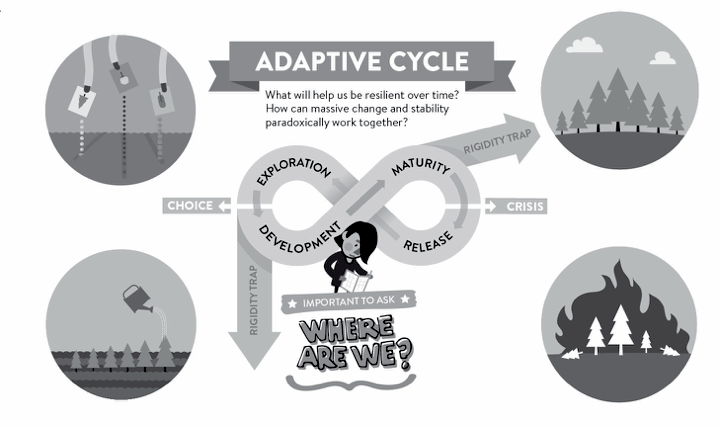Adaptive Cycle
Episode #7 of the course 10 tools for change by Kate Sutherland
So glad you are here again!
Today, we’ll explore the Adaptive Cycle, a framework that helps us see how natural and human systems cycle through phases of creation and destruction.
This tool takes the long view—an important perspective in our current crisis/short-term fixated world. It busts the linear growth “world as machine” paradigm that has been dominant for the past five hundred years!
Read on to gain a tool used by social innovators and others focused on creating a better world through systems change.
Origins
The inspiration for the Adaptive Cycle came from studying nature. In the 1950s, “Buzz” Holling, an ecological scientist, had a passion to understand population processes. He asked, “What are the relationships between predator and prey?” In the course of his research, he developed models that were “simple, but not too simple,” and explained population processes for insects, birds, fish, and even submarines!
Holling learned from nature to look for the interplay of slow and quick variables. His study of forest ecology, for example, taught him that common “decades-long fire protection policies” (slow) by forest managers have contributed to the widespread demise of forests due, among other factors, to outbreaks of insects (quick).
In other words, where humans have interfered with nature, nature’s rules have ultimately reasserted themselves. It turns out that Holling’s work, so firmly rooted in ecological science, also has important light to shed on human systems.
Adaptive Cycle
The fruit of successfully moving through the Adaptive Cycle is “resilience.” Here’s the definition that first ignited my interest in this framework:
“Resilience is the capacity to experience massive change and yet still maintain the integrity of the original. Resilience isn’t about balancing change and stability. It isn’t about reaching an equilibrium state. Rather, it is about how massive change and stability paradoxically work together.”

From studying what supports long-term resilience in forests and other ecosystems, Holling identified the Adaptive Cycle. Shown graphically, a system that is resilient loops continuously through the following four stages:
1. Release: A disaster or crisis, such as a forest fire, destroys existing structures. While generally lamented, the destruction releases resources for new growth.
2. Exploration: This is a time of exciting new opportunities and new connections. There is intense competition for resources as new strategies jockey for position.
3. Development: The system picks a small number of winning options and invests heavily in them.
4. Maturity: The system matures. Structures are developed and become dominant. There is little room and few resources for new ideas or ways of doing things.
In a forest and many social systems, Release and Exploration (the “back loop”) are quick phases, lasting days or months, and Development and Maturity (the “front loop”) are slow phases, lasting years or decades.
Stuck in Traps?
It follows that lack of resilience (and system dis-ease) comes from getting stuck in one of four ways:
1. The rigidity trap: The system fails to release resources for new growth (innovation!) and rigidifies.
2. The chronic disaster trap: The system is unable to get sufficient traction to leave the (traumatic) release phase and move forward.
3. The poverty trap: Resources are spread too thin, or none of the new ideas take root enough to move to the next phase.
4. The parasitic trap: This is a form of Founder’s Syndrome. For example, it’s not letting go of control, thereby blocking an initiative from becoming more structured, formalized and scalable or being too dependent on an initial host or founder.
Application?
What light does this framework shed on your own life and group or on the issues making headlines in your community?
In recent years, this framework has been plumbed for insights into all sorts of contexts, including small businesses, social programs, and local economies. What if budget cutbacks are like Holling’s forest fires? What if our medical, judicial, and educational systems are trapped in rigidity? These and other questions point to embracing change (innovation) as a crucial element in resilient/healthy systems!
Sparking Conversations
I hope you will share the Adaptive Cycle framework with others. Doing so is a great way to spark more courageous conversations. By offering a simple, powerful, and big-picture way to name what is, it helps group members get on the same page and opens space for facing tough issues and making bold choices.
Like many, I want to deny the need for such “tough love.” Holling’s framework shows the cost of denial and avoidance and encourages us to embrace change (release), to value small-scale experimentation (exploration), and to be ready to seize opportunities (development).
Tomorrow, we shift from the long view to focus on the moment-by-moment dynamics in human systems, thanks to Process Oriented Psychology, or POP. I use the POP framework on a daily basis and consider it one of the most versatile and powerful in the course.
See you!
Kate
Recommended reading
“Global Resilience Requires Novelty: A Speech” by Buzz Holling
Share with friends

